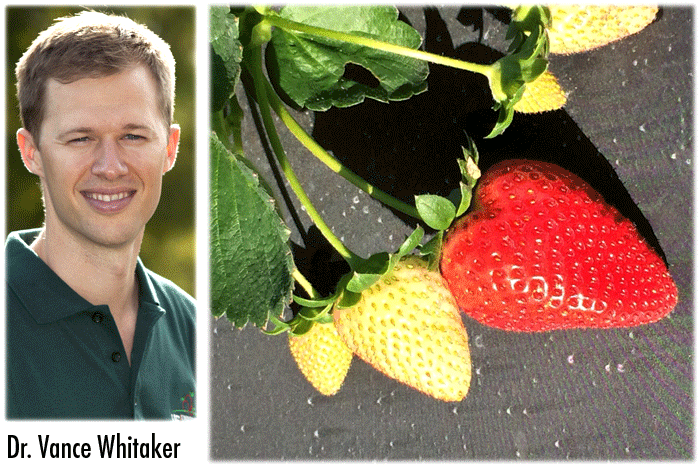| How Vance Whitaker invented a better berry |
In Vance Whitaker’s office in Wimauma, a philodendron vine drops out of the ceiling, seemingly from nowhere. The vine is older than he is.
You have to peek into the next office to find the potted plant that put forth the vine that snakes through the ceiling and over a wall to reach Whitaker. Jay Scott keeps the pot. He’s lugged the philodendron around with him since the 1970s. Scott waters the roots. Whitaker trains the vine. It’s a wonderful metaphor for the succession of knowledge that makes it possible for the Gulf Coast Research and Education Center to be such a hotbed of plant breeding — and how scientific progress works.
Whitaker is one of a new generation of research hotshots at the center. He breeds strawberries, and it’s his creation that the Florida Strawberry Growers Association has rallied behind to brand as Sweet Sensation™.
The consumer will see different labeling. Traditionally, the plastic clamshell identifies the farm and could hold any number of possible berry varieties. The Sweet Sensation™ sticker signals that the berries — grown on scattered farms in Hillsborough County — are Whitaker’s flavorful single breed.
In the face of low-cost competition from Mexico, Florida’s strawberry growers (most of whom are in the Hillsborough and Polk County area) have to make their case on quality. With Whitaker’s berry, I think if you try it, you’ll buy it. The Sweet Sensation™ rollout will be a small-scale experiment at select supermarkets to see if we have the strawberry version of the Tasti-Lee tomato — Jay Scott’s creation and smash commercial success.
Whitaker isn’t the only up-and-comer at GCREC. Sam Hutton is chasing a tomato grower’s grail — a breed that can be harvested mechanically. Natalia Peres has come up with a strawberry-monitoring web system that can reduce fungicide spraying enough to boost profits by $170,000 a year on a 26-acre farm.
Whitaker is the first to tell you that he stands on the shoulders of giants. He didn’t invent the strawberry. He invented a better strawberry. He arrived in Wimauma six years ago, just in time to benefit from the tutelage of Craig Chandler’s last year at the center. Chandler passed on to Whitaker some promising strawberry candidates. Through laborious cuttings and crossings, genetic work and walking shoulder-to-shoulder with Chandler in the field, Whitaker eventually bred Sweet Sensation™.
Chandler’s work goes back to the 1980s, when he worked under Charles Howard, whose career reached back to the 1960s. Chandler was so indebted to Howard’s mentorship that after Howard’s death, he released a strawberry variety under the name Sweet Charlie.
So, the Sweet Sensation’s™ roots go decades deep. Agricultural research is a long game. It builds painstakingly on the knowledge developed by predecessors. That’s why the investment in it has to be consistent. Imagine if we hadn’t had the state support to bring on Whitaker before Chandler retired. That long chain would have been broken. There would have been no shoulders for Vance to stand on.
Strawberries are a $400 million-a-year industry in Florida, and 80 percent of the acres are planted in UF/IFAS varieties. This is a perfect example of respected academics’ estimate that there’s a 20-to-1 return on investment in agricultural research.
We can never let up, though, in our support for research and development for the state’s farms. We face a key moment where policy makers are talking openly about an innovation deficit in America — a gap between what we need to invest to keep our competitive edge and what we actually spend to make breakthroughs possible.
The strawberry industry shows us how this investment pays off. With the economy improving and the state budget picture much brighter than it has been in years, we have an opportunity to put resources into innovation, the very thing that drove our post-World War II economic ascension and has kept us a world economic power.
When Jay Scott retires next year, I hope he’ll bequeath the entire philodendron to Whitaker, not just the vine. And before Whitaker retires decades from now, I hope he’ll be able to look back at a smash success for the Sweet Sensation™, and that he’ll thread that philodendron vine through the ceiling of an office occupied by a young, eager scientist — one who may not even have been born yet.
CREDIT
article by JACK PAYNE
ABOUT THE AUTHOR: Jack Payne is the University of Florida’s senior vice president for agriculture and natural resources and head of the Institute of Food and Agricultural Sciences (IFAS).

